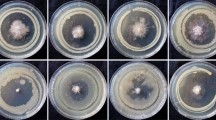Summary
Forty-three strains of feeder root colonizing fluorescent pseudomonads from rough lemon (Citrus jambhiri Lush.) roots were examined for effects on rough lemon and sweet orange (Citrus sinensis Osbeck) seedlings. Plants inoculated with a single bacterial soil-drench had, after 10 months, a range of stimulatory (to 116%) and inhibitory effects (to 52%). Stimulatory bacteria particularly increased growth of root systems. Cultivar-specific inhibition and stimulation was evident in inoculations of rough lemon and sweet orange seedlings. Populations of fluorescent rhizobacteria on inoculated and noninoculated, as well as on stimulated and nonstimulated seedlings, did not differ significantly (10.8×106 to 30.3×106 CFU/g root). Population of fluorescent rhizobacteria on seedlings were higher than populations on feeder roots from grove trees (2.8 to 5.7×106 CFU/g). Ninety-four and 81% of 251 fluorescent strains produced antibiotics against the fungusGeotrichum candidum and the bacteriumErwinia stewartii, respectively. Antibiotic activities of 90% of the antibiotic producing strains were repressed by Fe3+, indicating siderophore production. In comparison, only 9.6 and 15% of 94 randomly selected nonfluorescentPseudomonas strains were antibiotic producers. Differences between stimulatory and inhibitory or neutral bacteria were not apparent from antibiosis tests. On the basis of physiological tests,Pseudomonas putida was the most abundant (>62%) pseudomonad species on rough lemon roots. Growth stimulating strains appeared to be in bothP. putida andP. fluorescens groups. FewP. aeruginosa strains were identified on citrus roots.
Similar content being viewed by others
References
Catska V, Vancura V, Hudska G and Prikryl Z 1982 Rhizosphere micro-organisms in relation to the apple replant problem. Plant and Soil 69, 187–197.
Feldman A W and Gardner J M 1982 Root suppression of citrus budlings by citrus tristeza virus and byPseudomonas isolates from xylem of healthy and young tree decline-affected citrus trees. Proc. Soil Crop Sci. Soc. Fla. 41, 25–28.
Gardner J M, Feldman A W and Zablotowicz R M 1982 Identity and behaviour of xylem-residing bacteria in rough lemon roots of Florida citrus trees. Appl. Environ. Microbiol. 43, 1335–1342.
Gasson M J 1980 Indicator technique for antimetabolite toxin production by phytopathogenic species ofPseudomonas. Appl. Environ. Microbiol. 39, 25–29.
Kado C I and Heskett M G 1970 Selective medium for the isolation ofAgrobacterium, Corynebacterium, Erwinia, Pseudomonas, andXanthomonas. Phytopathology 60, 956–976.
Kloepper J W, Leong J, Teintze M and Schroth M N 1980 Enhanced plant growth by siderophores produced by plant growth promoting rhizobacteria. Nature London 286, 885–886.
Misaghi I J, Stowell L J, Grogan R G and Spearman L C 1982 Fungistatic activity of water-soluble fluorescent pigments of fluorescent pseudomonads. Phytopathology 72, 33–36.
Sands D C, Schroth M N and Hildebrand D C 1970 Taxonomy of phytopathogenic pseudomonads. J. Bacteriol. 101, 9–23.
Schroth M N and Hancock J G 1982 Disease suppressive soil and root colonizing bacteria. Science 216, 1376–1381.
Stanier R Y, Palleroni N J and Doudoroff M 1966 The aerobic pseudomonads: a taxonomic study. J. Gen. Microbiol. 43, 159–271.
Suslow T V and Schroth M N 1981 Bacterial culture preservation in frozen and dry-film methylcellulose. Appl. Environ. Microbiol. 42, 872–877.
Suslow T V and Schroth M N 1982 Role of deleterious bacteria as minor pathogens in reducing crop growth. Phytopathology 72, 111–115.
Author information
Authors and Affiliations
Additional information
Florida Agricultural Experiment Stations Journal Series No.
Rights and permissions
About this article
Cite this article
Gardner, J.M., Chandler, J.L. & Feldman, A.W. Growth promotion and inhibition by antibiotic-producing fluorescent pseudomonads on citrus roots. Plant Soil 77, 103–113 (1984). https://doi.org/10.1007/BF02182816
Received:
Issue Date:
DOI: https://doi.org/10.1007/BF02182816




